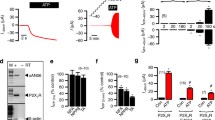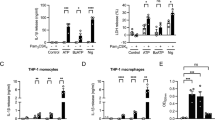Abstract
The response to ATP of peritoneal macrophages from wild-type (WT) and P2X7-invalidated (KO) mice was tested. Low concentrations (1–100 μM) of ATP transiently increased the intracellular concentration of calcium ([Ca2+]i) in cells from both mice. The inhibition of the polyphosphoinositide-specific phospholipase C with U73122 inhibited this response especially in WT mice suggesting that the responses coupled to P2Y receptors were potentiated by the expression of P2X7 receptors. One millimolar ATP provoked a sustained increase in the [Ca2+]i only in WT mice. The response to 10 μM ATP was potentiated and prolonged by ivermectin in both mice. One millimolar ATP increased the influx of extracellular calcium, decreased the intracellular concentration of potassium ([K+]i) and stimulated the secretion of interleukin-1β (IL-1β) only in cells from WT mice. Ten micromolar ATP in combination with 3 μM ivermectin reproduced these responses both in WT and KO mice. The secretion of IL-1β was also increased by nigericin in WT mice and the secretory effect of a combination of ivermectin with ATP in KO mice was suppressed in a medium containing a high concentration of potassium. In WT mice, 150 μM BzATP stimulated the uptake of YOPRO-1. Incubation of macrophages from WT and KO mice with 10 μM ATP resulted in a small increase of YOPRO-1 uptake, which was potentiated by addition of 3 μM ivermectin. The uptake of this dye was unaffected by pannexin-1 blockers. In conclusion, prolonged stimulation of P2X4 receptors by a combination of low concentrations of ATP plus ivermectin produced a sustained activation of the non-selective cation channel coupled to this receptor. The ensuing variations of the [K+]i triggered the secretion of IL-1β. Pore formation was also triggered by activation of P2X4 receptors. Higher concentrations of ATP elicited similar responses after binding to P2X7 receptors. The expression of the P2X7 receptors was also coupled to a better response to P2Y receptors.









Similar content being viewed by others
Abbreviations
- WT:
-
wild-type
- KO:
-
knockout
- PPI-PLC:
-
polyphosphoinositide-specific phospholipase C
- HBS:
-
HEPES-buffered saline
- TEEI buffer:
-
Tris/EGTA/EDTA/protease inhibitors buffer
- LPS:
-
lipopolysaccharide
- IL-1β:
-
interleukin-1β
- NMDG:
-
N-methyl-D-glucamine
- PBS:
-
phosphate-buffered saline
- BSA:
-
bovine serum albumin
- FBS:
-
fetal bovine serum
- HRP:
-
horseradish peroxidase
- PAGE:
-
polyacrylamide gel electrophoresis
References
Solle M, Labasi J, Perregaux DG, Stam E, Petrushova N, Koller BH, Griffiths RJ, Gabel CA (2001) Altered cytokine production in mice lacking P2X7 receptors. J Biol Chem 276:125–132
Ralevic V, Burnstock G (1998) Receptors for purines and pyrimidines. Pharmacol Rev 50:413–492
Kim M, Jiang LH, Wilson HL, North RA, Surprenant A (2001) Proteomic and functional evidence for a P2X7 receptor signalling complex. EMBO J 20:6347–6358
Surprenant A, Rassendren F, Kawashima E, North RA, Buell G (1996) The cytolytic P2Z receptor for extracellular ATP identified as a P2X receptor P2X7. Science 272:735–738
Mariathasan S, Weiss DS, Newton K, McBride J, O’Rourke K, Roose-Girma M, Lee WP, Weinrauch Y, Monack DM, Dixit VM (2006) Cryopyrin activates the inflammasome in response to toxins and ATP. Nature 440:228–232
Perregaux D, Gabel CA (1994) Interleukin-1 beta maturation and release in response to ATP and nigericin. Evidence that potassium depletion mediated by these agents is a necessary and common feature of their activity. J Biol Chem 269:15195–15203
Pétrilli V, Papin S, Dostert C, Mayor A, Martinon F, Tschopp J (2007) Activation of the NALP3 inflammasome is triggered by low intracellular potassium concentration. Cell Death Differ 14:1583–1589
Brône B, Moechars D, Marrannes R, Mercken M, Meert T (2007) P2X currents in peritoneal macrophages of wild type and P2X −/−4 mice. Immunol Lett 113:83–89
Sim JA, Park C-K, Oh SB, Evans RJ, North RA (2007) P2X1 and P2X4 receptor currents in mouse macrophages. Br J Pharm 152:1283–1290
Taylor HR, Pacqué M, Muñoz B, Greene BM (1990) Impact of mass treatment of onchocerciasis with ivermectin on the transmission of infection. Science 250:116–118
Toulmé E, Soto F, Garret M, Boué-Grabot E (2006) Functional properties of internalization-deficient P2X4 receptors reveal a novel mechanism of ligand-gated channel facilitation by ivermectin. Mol Pharmacol 69:576–587
McCarron RM, Goroff DK, Luhr JE, Murphy MA, Herscowitz HB (1984) Methods for the collection of peritoneal and alveolar macrophages. Methods Enzymol 108:274–284
Grynkiewicz G, Poenie M, Tsien RY (1985) A new generation of Ca2+ indicators with greatly improved fluorescence properties. J Biol Chem 260:3440–3450
Michel AD, Chessell IP, Humphrey PP (1999) Ionic effects on human recombinant P2X7 receptor function. Naunyn Schmiedebergs Arch Pharmacol 359:102–109
Kahlenberg JM, Dubyak GR (2004) Mechanisms of caspase-1 activation by P2X7 receptor-mediated K+ release. Am J Physiol Cell Physiol 286:C1100–C1108
Bleasdale JE, Thakur NR, Gremban RS, Bundy GL, Fitzpatrick FA, Smith RJ, Bunting S (1990) Selective inhibition of receptor-coupled phospholipase C-dependent processes in human platelets and polymorphonuclear neutrophils. J Pharmacol Exp Ther 255:756–768
Khakh BS, Proctor WR, Dunwiddie TV, Labarca C, Lester HA (1999) Allosteric control of gating and kinetics at P2X4 receptor channels. J Neurosci 19:7289–7299
Hickman SE, el Khoury J, Greenberg S, Schieren I, Silverstein SC (1994) P2Z adenosine triphosphate receptor activity in cultured human monocyte-derived macrophages. Blood 84:2452–2456
Donnelly-Roberts DL, Namovic MT, Han P, Jarvis MF (2009) Mammalian P2X7 receptor pharmacology: comparison of recombinant mouse, rat and human P2X7 receptors. Br J Pharmacol 157:1203–1214
Pelegrin P, Surprenant A (2006) Pannexin-1 mediates large pore formation and interleukin-1beta release by the ATP-gated P2X7 receptor. EMBO J 25:5071–5082
Métioui M, Amsallem H, Alzola E, Chaïb N, Elyamani A, Moran A, Marino A, Dehaye JP (1996) Low affinity purinergic receptor modulates the response of rat submandibular glands to carbachol and substance P. J Cell Physiol 188:462–475
Adinolfi E, Callegari MG, Cirillo M, Pinton P, Giorgi C, Cavagna D, Rizzuto R, Di Virgilio F (2009) Expression of the P2X7 receptor increases the Ca2+ content of the endoplasmic reticulum, activates NFATc1 and protects from apoptosis. J Biol Chem 284:10120–10128
Turner JT, Park M, Camden JM, Weisman GA (1998) Salivary gland nucleotide receptors. Changes in expression and activity related to development and tissue damage. Ann NY Acad Sci 842:70–75
Stokes L, Surprenant A (2009) Dynamic regulation of the P2X(4) receptor in alveolar macrophages by phagocytosis and classical activation. Eur J Immunol 39:986–995
Ito M, Matsuoka I (2008) Regulation of purinergic signaling by prostaglandin E2 in murine macrophages. J Pharmacol Sci 107:443–450
Nicke A, Kerschensteiner D, Soto F (2005) Biochemical and functional evidence for heteromeric assembly of P2X1 and P2X4 subunits. J Neurochem 92:925–933
Ferrari D, Pizzirani C, Adinolfi E, Lemoli RM, Curti A, Idzko M, Panther E, Di Virgilio F (2006) The P2X7 receptor: a key player in IL-1 processing and release. J Immunol 176:3877–3883
Guo C, Masin M, Qureshi OS, Murrell-Lagnado RD (2007) Evidence for functional P2X4/P2X7 heteromeric receptors. Mol Pharmacol 72:1447–1456
Perregaux D, Barberia J, Lanzetti AJ, Geoghegan KF, Carty TJ, Gabel CA (1992) IL-1 beta maturation: evidence that mature cytokine formation can be induced specifically by nigericin. J Immunol 149:1294–1303
Netea MG, Simon A, van de Veerdonk F, Kullberg BJ, Van der Meer JW, Joosten LA (2010) IL-1beta processing in host defense: beyond the inflammasomes. PLoS Pathog 6:e1000661
Khakh BS, Bao XR, Labarca C, Lester HA (1999) Neuronal P2X transmitter-gated cation channels change their ion selectivity in seconds. Nat Neurosci 2:322–330
Shinozaki Y, Sumitomo K, Tsuda M, Koizumi S, Inoue K et al (2009) Direct observation of ATP-induced conformational changes in single P2X4 receptors. PLoS Biol 7(5):e1000103
Iglesias R, Locovei S, Roque AP, Alberto AP, Dahl G, Spray DC, Scemes E (2008) P2X7 receptor-Pannexin1 complex: pharmacology and signaling. Am J Physiol Cell Physiol 295:C752–C760
Chaumont S, Khakh BS (2008) Patch-clamp coordinated spectroscopy shows P2X2 receptor permeability dynamics require cytosolic domain rearrangements but not Panx-1 channels. Proc Natl Acad Sci USA 105:12063–12068
Piccini A, Carta S, Tassi S, Lasiglié D, Fossati G, Rubartelli A (2008) ATP is released by monocytes stimulated with pathogen-sensing receptor ligands and induces IL-1beta and IL-18 secretion in an autocrine way. Proc Natl Acad Sci USA 105:8067–8072
Bobanovic LK, Royle SJ, Murrell-Lagnado RD (2002) P2X receptor trafficking in neurons is subunit specific. J Neurosci 22:4814–4824
Boumechache M, Masin M, Edwardson JM, Górecki DC, Murrell-Lagnado R (2009) Analysis of assembly and trafficking of native P2X4 and P2X7 receptor complexes in rodent immune cells. J Biol Chem 284:13446–13454
Acknowledgment
This work was supported by grant n° 3.4.528.07 from the Fonds National de la Recherche Scientifique Médicale to JPD and by grant n° BFU/2007-62728 BMC from the Ministry of Education to AM. SP was a postdoctoral fellow from the Fonds National de la Recherche Scientifique. The authors thank Ms. S Dulanto for her skillful technical help.
Author information
Authors and Affiliations
Corresponding author
Rights and permissions
About this article
Cite this article
Seil, M., El Ouaaliti, M., Fontanils, U. et al. Ivermectin-dependent release of IL-1beta in response to ATP by peritoneal macrophages from P2X7-KO mice. Purinergic Signalling 6, 405–416 (2010). https://doi.org/10.1007/s11302-010-9205-8
Received:
Accepted:
Published:
Issue Date:
DOI: https://doi.org/10.1007/s11302-010-9205-8




